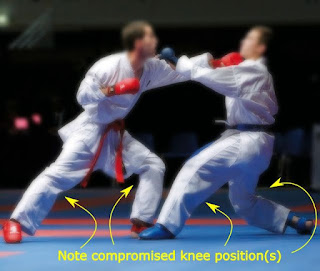Back to the basics
In my training, I live a dichotomy.
Within my karate training, basics are not overly encouraged as practice on their own. One is expected to learn and understand basics through kata.
Within my kobudo, basics are strongly emphasized before kata is taught.
So, which way is right? Well, therein lies the conundrum.
We've all seen the bad technique guy? In fact, there are videos dedicated to bad form. Maybe you've seen this guy?
 |
| captured from Youtube.com |
And you have likely seen bad stances in the execution of technique? This image points it out in spades.
 |
| Captured from Pinterest |
There is an old adage I use in class - " practice doesn't make perfect. perfect practice makes perfect."
There is also the variation that 'practice makes permanent.' Pick any art, any activity of a physical nature and you will know that there are correct ways to do things and incorrect ways to do things. The correct routes are finite.
Back in my police training days, it was passed on that drawing the service weapon was a process that required a minimum of 5000 repetitions to make it automatic. We were also told that improper draws would require a correction of 100 times for each improper action.
Weight training is much the same way. There is a precise range of movement to achieve best results. Take a shortcut or make uninformed variations and you lose mechanical advantage - worse, you injure yourself.
Techniques cannot be rote, not can kata.
I have had students join my dojo over the years with experience from elsewhere. I can always tell those who are 'set in their ways.' They are the ones who still figure that karate must use muscle to generate force. They typically do not last long when I begin to makes changes to posture, structure. etc
The eyes begin to roll, and the braying about 'formless form' and 'rigid karate' begins. But here's the thing basics do not make us rigid. They release us from rigidity.
I use a very basic analogy in class when talking about the evolution of one's karate. I liken it to language. We started with learning letters, then words, then sentences. Eventually, we put those sentences together to make stories, etc.
Karate begins with the general use of arms, legs and body - either static or in motion - to understand how we maximize natural body movement to block, strike or other (lock up, throw, trip, etc). Stop following the basics and things work poorly for you.
Sorta like not following order of proper sentence structure means people may not understand what the hell you're saying.
So, what the hell does this have to do with my dichotomy - my general martial conundrum?
The essential trick I learned years ago whilst training - when in Rome (or Okinawa), do whatever the Roman (or Okinawan) in front of you tells you.
Pretty simply, no?
I recognize what my karate sensei is trying to tell me. And I wholly believe what he says. Perhaps it works with Okinawans. But, I have seen westerners long enough to know we look pretty damn goofy for the most part when we are doing basics. Our hips down move the right way, our backs tilt forward. Our elbows flare out and our shoulders roll up. We think of power generation very differently from the Japanese/ Okinawans. We' think upper body.
So I compromise.
The first month or so folks are in my dojo, they'll get a heavy sampling of basics and regular kata. But they will spend a pile of time moving forward and back, being told to keep their feet in a certain way, their elbows and shoulders down and their hips tucked.
For kobudo?
Well, let's just say a turtle moves faster. Working the basics is a iterative process. I just slow it down a whole bunch more.
I noticed that my kobudo sensei did the same thing this year at the annual seminar. It was much slower then I remember doing it for a long time- if ever - in that context.
It was not appreciated by all. And to that I say, too bad for you.
Remember, the guy at the front makes the rules.
But you understand how to make that weapon move in the way it should.
Being largely on my own with my kobudo, I have had to learn largely my trial and error. I have had to study and explore how things fit together - and how to get things to fit the right way. I take the instructions and corrections and apply them as best as I can.
So my karate moves fast if you compare it to my kobudo.
I won't win any medals, but I do not need to.
I just need to make sure I stick to the basics - in everything I do. :)

Comments